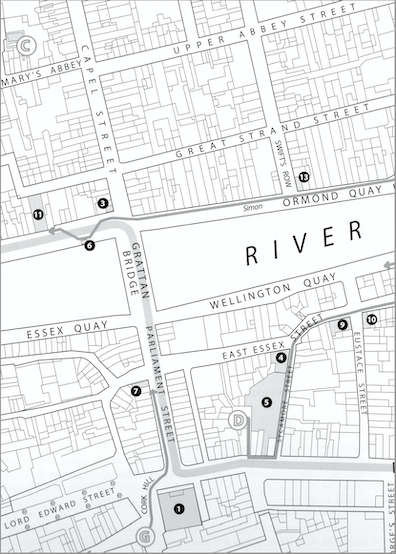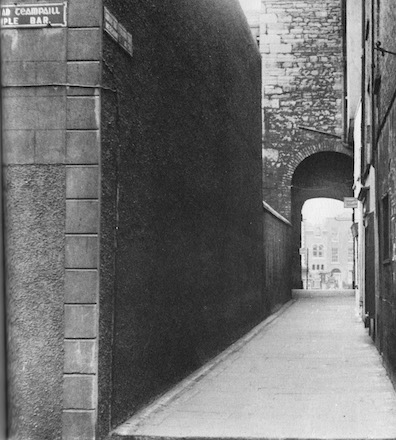Newcomers can easily become disoriented in the labyrinthine
medieval streets of Dublin. The "tiny square of Crampton
court" is one of its more obscure nooks. Two narrow
alleyways between buildings on Dame Street in the south and
Essex Street East in the north meet in a small courtyard at
the back entrance of the Olympia Theatre, which in Joyce's
youth was Dan Lowrey's Music Hall and, after 1897, the Empire
Palace Theatre. Section 9 opens with Tom Rochford showing his
three companions a device for letting music hall patrons know
which number is currently being performed, and then Lenehan
and M'Coy go "out" into this tiny courtyard, so they must be
exiting from the back door of the music hall.
The subsequent street directions show that the two men do not
walk down to Essex Street but instead go up to Dame Street,
where they turn left and then left again on Sycamore Street.
Joyce makes the journey more confusing by mentioning the music
hall twice under its two names (one of them misspelled, as
Slote notes): "They passed Dan Lowry's musichall where
Marie Kendall, charming soubrette, smiled on them from a
poster a dauby smile. / Going down the path of
Sycamore street beside the Empire musichall Lenehan
showed M'Coy how the whole thing was." It sounds as if they
are passing different buildings but in fact they are seeing
the same establishment, which had entrances on both its Dame
Street and Sycamore Street facades as indicated in Thom's
1904 directory.
When they get to Essex Street, they find themselves "At
the Dolphin," a hotel and restaurant which once stood on
the corner. Here, instead of turning left toward the Ormond
Hotel, Lenehan takes a right toward "Lynam's," a bookmaker he knows.
(No one today can say with certainty which building may have
housed this illegal betting operation, and Joyce does not give
readers much help.) Responding to Lenehan's asking what time
it is, "M'Coy peered into Marcus Tertius Moses' sombre
office, then at O'Neill's clock." They have now moved
one block east to the meeting of Essex and Eustace Street,
where rival tea merchants sat on opposite corners of the
intersection. The time, M'Coy says, is "After three," which
means that in England it is after 3:25.
The race there was scheduled to start at 3, so it has already
happened, but the news was not due to reach Dublin by
telegraph until 4 so bookies were still taking bets. (Parallax
and technology here add temporal wrinkles to the deepening
spatial ones.)
Lenehan leads M'Coy forward into "Temple bar," which
continues Essex Street East eastward under a new name––an
omnipresent source of confusion to people visiting Dublin. (At
its other end Temple Bar becomes Fleet Street. There are
dozens, perhaps hundreds of similar examples in this old
city.) He leaves M'Coy standing there while he goes to talk to
the bookmaker, returning shortly later to report that it's
"Even money." Then he directs his companion "Through here.
/ They went up the steps and under Merchants' arch. A
darkbacked figure scanned books on the hawker's cart."
Merchants' Arch is another quirky, captivating feature of the
old Dublin streets. It provides a mid-block pedestrian
shortcut from Temple Bar to Wellington Quay via another narrow
alleyway and a tall narrow archway.
The following section will show (almost certainly) that the
"darkbacked figure" standing at the cart is Leopold Bloom,
since he is seen there browsing in a nearby bookstore. Thus it
may possibly seem that the sentence mentioning this man is an
interpolation drawing attention to section 10, but Lenehan and
M'Coy do actually see Bloom, as evidenced by the long
discussion they have about him after passing by. The
uncertainty a reader may feel here repeats the trick played in
section 2, when a sentence about Father Conmee boarding a tram
seems to be an interpolation echoing the previous section (it
may in fact
be one) but is also happening in present time and space.
Finally the narrative shows Lenehan and M'Coy coming out of
the alley and moving west: "They crossed to the metal
bridge and went along Wellington quay by the riverwall."
There is potential for a final bit of confusion here. The span
called the Metal Bridge or Ha'Penny Bridge does cross the
Liffey beyond the Merchants' Arch alleyway, so being told that
the two men "crossed to the metal bridge" may create the
impression that they take this bridge across the river. But in
fact they only cross the road. Spurning the bridge, they turn
left and walk along the riverine side of Wellington Quay. This
will take them to the Grattan Bridge, which they could have
accessed much more quickly from Crampton Court were it not for
Lenehan's detour to visit the bookmaker.
Readers who follow all these spatial twists and turns must
also recognize that they are not entering locations
evoked by four interpolated passages. The first looks ahead to
section 19: "Lawyers of the past, haughty, pleading, beheld
pass from the consolidated taxing office to Nisi Prius court
Richie Goulding carrying the costbag of Goulding, Collis and
Ward and heard rustling from the admiralty division of
king's bench to the court of appeal an elderly female with
false teeth smiling incredulously and a black silk skirt of
great amplitude." This scene is set farther west along
the quays in the entrance hall of the Four
Courts building, which lies beyond the Ormond on the
north bank of the river. So far in this episode, every
interpolation has borne some evident thematic connection to
the section it interrupts, usually to sentences just before or
after. This one is hard to make sense of in that way, and that
is not its only puzzling feature. It also stands in a strange
temporal relation to the next interpolation.
This one too anticipates section 19, glancing even farther
west to Phoenix Park where the viceregal procession is setting
out: "The gates of the drive opened wide to give egress to
the viceregal cavalcade." The horses of the procession
clearly echo the horses that Lenehan is betting on, but
hearing about the cavalcade after hearing about the "Lawyers
of the past" is odd, because readers have become accustomed to
interpolations that either evoke simultaneity or move time
slightly forward. Here, the order of the two interpolations
appears to reverse the actual order of events. Section 19
shows Richie Goulding standing "In the porch of Four Courts"
and watching the cavalcade go by, several sentences after
the cavalcade is shown leaving through the gates of Phoenix
Park––as well it should, since the parade moves east along the
river, from the park to "Kingsbridge," to "Bloody bridge," to
"Queen's and Whitworth bridges," to the Four Courts.
In section 9 one hears first of Richie Goulding in the Four
Courts and then, oddly, of the procession leaving Phoenix
Park. But this time there is an evident solution to the
puzzle, though it does involve a narrative trick requiring
readers to pay close attention. If one looks closely at the
interpolation, it does not say that Richie Goulding saw the
viceroy, as in section 19. It says instead that the lawyers in
the entrance hall saw Richie Goulding. This means that
the interpolation is representing an earlier moment in the
action, unrepresented in section 19, when Richie had not yet
made his way out of the building. After he emerges onto the
porch that fronts the quay he sees the viceroy passing below
its steps. So, by a sly trick, the forward movement of time is
both threatened and preserved. Joyce uses this interpolation
to jump to a moment earlier than the actions seen in the final
section.
In his fourth interpolation he does the opposite, moving time
forward to a later unrepresented moment. This one revisits the
facade of the Blooms' house as glimpsed in section 3:
"A card Unfurnished Apartments reappeared on the
windowsash of number 7 Eccles street." In section 3 the
card advertising rooms for rent falls out of Molly's window.
In section 9 it reappears in the window. The implication is
that some time passes between the two sections. It is probably
impossible to say how much time, but a sense of mimetic
verisimilitude is engendered by imagining Molly noticing that
the card has fallen out, going downstairs and walking outside
to pick it up, taking care of other domestic tasks, and
eventually replacing it in the window. (It is hard for me to
imagine Hart's justification for saying that the card falls
out at 3:16 and is replaced at 3:17. Surely more time has
passed between section 3 and section 9?) This interpolation,
unlike the one about the statues of lawyers in the Four
Courts, also weaves a thematic continuity with other details
in the section, as Lenehan is engaged in telling a lascivious
story about Molly Bloom.
The third interpolation anticipates section 18, where Paddy
Dignam's son Patsy will be seen leaving a butcher shop on
William Street, quite a few blocks to the southeast: "Master
Patrick Aloysius Dignam came out of Mangan's, late
Fehrenbach's, carrying a pound and a half of porksteaks."
Clive Hart observes that there is an "ironic similarity"
between the Glencree Reformatory where Lenehan's story begins
and the O'Brien Institute where Father Conmee is trying to
find a place for young Dignam (Critical Essays,
208). This seems correct, but he also notes "The contrast in
the quality of the foodstuffs." A contrast there certainly is
(at the annual fundraising dinner there were "port wine and
sherry and curacao," and "Cold joints galore and mince pies"),
but I wonder if the funeral dinner at the Dignam house isn't
in its own small way unusually extravagant.
Making sense of the spatial movements in section 9 is arduous
work. The most crowded previous section, Father
Conmee's walk to Artane, covered a lot of ground and
glanced at many streets and now-defunct institutions, but it
started and ended at prominent landmarks and followed a more
or less linear course. Section 9, by contrast, starts in an
unnamed interior space, moves into a small open-air nook
unfamiliar even to many Dubliners, uses two names for one
building, and follows a circuitous walking course that punches
through city blocks but is by no means the shortest distance
between two points. Two of its four interpolations jump to
familiar places but tinker with the time, requiring readers to
augment the narration with things that happen earlier or
later, and what might seem to be a fifth interpolation taking
readers to the following section in fact is happening in
present time and space. Added to all these intricacies are the
multiple thematic threads––sexual arousal, fine eating, harsh
educational institutions, horseracing––that can be teased out
of the interstices between interpolations and surrounding
text.
It is almost as if, in this centrally placed section (number
9 of 19), Joyce wanted to maximize the disorienting jumps
across space, time, people, and subject matters that he was
exploring throughout the entire chapter. The reader who can
get through the labyrinth holding on to all these threads
deserves a medal. Things get easier in the next chunk of text.
Much as Calypso provides comforting clarity to readers
who have struggled through the obscurities of Proteus,
section 10 provides some relief from the challenges of section
9. It stays in one spot, somewhere near the bookseller's cart.







